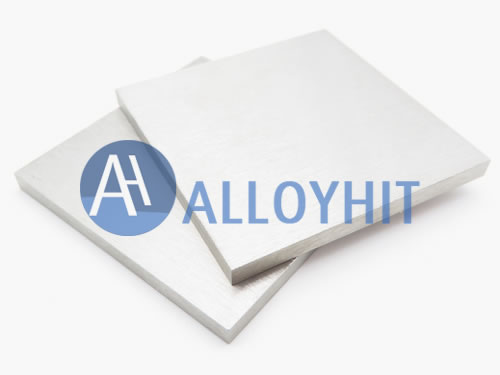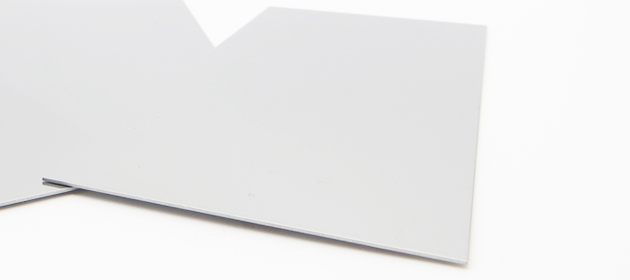
C103 Sheet/Foil
The plastic-brittle transition temperature of C103(Nb-10Hf-1Ti) alloy is lower than -196℃, the recrystallization temperature is 900~1300℃, and the stress relief annealing temperature is 900℃. General hot extrusion (1200~1250℃, extrusion ratio 4:1), hot forging (1200℃), warm rolling (600℃ pass deformation 5~35%), cold rolling (total processing rate 80~90%) can be used. %) and other technologies to roll various specifications of plates. Sheet processing performance, spinning performance is good.
Product Specifications of Niobium C103 Sheets & Foil
Our Niobium C103 sheets & foil are available in a range of standard sizes and can be custom manufactured to meet your specific requirements.
| Parameter | Standard Range | Custom Options | Tolerance |
| Thickness | 0.010" - 0.250" (0.25mm - 6.35mm) | From0.002" - 0.500" (0.0508mm) | ±0.001" (±0.025mm) |
| Width | 1" - 24" (25.4mm - 609.6mm) | Up to 48" (1219.2mm) | ±0.030" (±0.76mm) |
| Length | 6" - 120" (152.4mm - 3048mm) | Up to 240" (6096mm) | ±0.125" (±3.18mm) |
| Alloy Composition | Nb-10Hf-1Ti (Niobium with 10% Hafnium, 1% Titanium) | ±0.5% for major elements | |
| Surface Finish | As-rolled, Pickled, Bright annealed | Polished (up to 20 Ra max) | - |
| Grain Size | ASTM B 654 | Custom grain structures available | - |
| Form | Sheets, Plates, Foil | Custom cut shapes, Rings, Discs | - |
Available Customizations of Niobium C103 Sheet & Foil
- Precision cutting to exact dimensions
- Waterjet and laser cutting for complex shapes
- Custom heat treatment for specific properties
- Surface coating application (e.g., silicide coatings)
- Full material traceability documentation
- MechAdditional testing (ultrasonic, X-ray, PMI)
- Certification to specific industry standards
- Custom packaging for international shipping
Why Choose Our Niobium C103 Sheets?
-
✔
Precision rolled to tight tolerances (±0.001") for consistent quality
-
✔
Vacuum melted for exceptional purity and reduced inclusions
-
✔
Custom sizes available from 0.005" to 0.5" thickness
-
✔
Comprehensive testing and certification with every order
-
✔
Global shipping with secure packaging and documentation

Precision Manufacturing Process of Niobium C103
Our Niobium C103 Sheet & Foil undergo a rigorous manufacturing process to ensure the highest quality and performance standards.
1. Alloy Preparation
High-purity niobium, hafnium, and titanium are precisely measured and blended according to the C103 specification (Nb-10Hf-1Ti) to ensure exact chemical composition.
2. Vacuum Arc Melting
The alloy is melted in a high-vacuum environment to eliminate gas impurities and ensure homogeneous composition, creating a uniform ingot structure.
3. Hot Rolling
The ingot is heated to precise temperatures and rolled to reduce thickness while enhancing mechanical properties through controlled deformation.
4. Cold Rolling & Annealing
Precision cold rolling achieves final thickness with tight tolerances, followed by vacuum annealing to optimize mechanical properties and remove residual stresses.
5. Quality Inspection & Testing
Each sheet undergoes rigorous testing including chemical analysis, mechanical property verification, ultrasonic inspection, and dimensional checks to ensure compliance.
Processing technology and technical specifications for C103 sheet/foil
Rolling requirements of C103 Sheet/Foil
Usually cold rolling is used, the total processing rate is controlled at 80%-90% of the slab thickness, and the pass processing rate is controlled at 6%-8% of the slab thickness. In order to ensure the surface quality of the plate, the forged slab blank is required to be free of defects, pollution, and the roller surface is smooth.
Forging requirements of C103 Sheet/Foil
Forging billeting is best to use press cold forging, the temperature rise of the forging should not exceed 400°C (the surface of the forging is blue at 400°C), and the uniformity of the material is good, which can reduce the pollution of gas impurities.
Cleaning requirements of C103 Sheet/Foil
Before annealing, the surface contamination layer must be removed by pickling. The pickling solution is configured with 65%-68% nitric acid, 90%-98% sulfuric acid and not less than 40% hydrofluoric acid in a volume ratio of 5:5:2, and rinse with water after pickling.
Heat treatment specification of C103 Sheet/Foil
In the vacuum state of 1×10^(-3)Pa, heat up to 800°C with the furnace, keep for 1 hour, C103 heat up to 1100-1600°C at no more than 20°C/min, keep the temperature for 2.5 hours, cut off and cool down It is baked at not more than 60°C.
Processing technology and heat treatment specification of C103 Sheet/Foil
Electron beam smelting niobium ingot → room temperature (or ≤400°C) forging billet → annealing → rough rolling → annealing → strip rolling → annealing → foil rolling → heat treatment.
International Standards Compliance of Niobium C03
Our Niobium C103 Sheet & Foil meet or exceed the most stringent international standards, ensuring global acceptance and reliability.

Certifications & Specifications
-
ASTM B654
Standard specification for niobium and niobium alloy sheet, strip, and foil, ensuring consistent quality and performance.
-
Other Compliance
ISO 9001 quality management and complete material traceability from raw material to finished product.
Quality Assurance
Material Testing
Comprehensive chemical analysis, mechanical testing, and non-destructive evaluation ensure material integrity.
Process Control
Strict process controls and continuous monitoring ensure consistent quality across all production batches.
Documentation
Complete certification packages including material test reports, traceability records, and compliance documentation.
Contact Us
If you have any questions or needs regarding Niobium C-103 Sheet products, please feel free to contact us and we will provide you with professional consulting services.

 +86 13120915623
+86 13120915623




